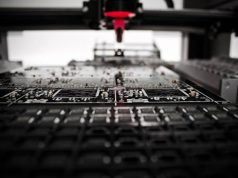Founded in 2016 by CEO Dr. Zining Wu, Innogrit Corporation is at the forefront of data storage innovation with its state-of-the-art PCIe Gen 4 SSD controllers. In the article below, InnoGrit Corporation delves into what 3D NAND technology is, its benefits, and how it enhances the capacity, speed, and reliability of modern SSDs, making high-capacity drives more accessible to consumers.
Solid State Drives (SSDs) have revolutionized how we store and access data, offering significant improvements over traditional Hard Disk Drives (HDDs) in terms of speed, reliability, and energy efficiency. At the heart of this revolution lies the advancement in NAND flash technology, particularly 3D NAND.
InnoGrit Corporation Highlights 3D NAND Technology
3D NAND is a type of flash memory where the memory cells are stacked vertically in multiple layers. Traditional NAND, also known as planar NAND, arranges memory cells in a single, two-dimensional layer. However, as manufacturers pushed for higher capacities and better performance, they faced physical limitations with planar NAND, such as interference between cells and limited scalability.
To overcome these limitations, 3D NAND technology was developed. By stacking layers of memory cells vertically, manufacturers can significantly increase the storage density without increasing the physical footprint of the chip. InnoGrit Corporation says that this vertical stacking is akin to building skyscrapers instead of spreading out horizontally, allowing for more efficient use of space.
How 3D NAND Enhances SSD Capacity
Increased Storage Density
One of the most significant advantages of 3D NAND technology is the dramatic increase in storage density. By stacking layers, manufacturers can fit more memory cells into the same physical space. For example, while planar NAND might have one layer of memory cells, 3D NAND can have 64, 96, or even more layers. This increase in density translates directly to higher capacity SSDs, allowing consumers to access drives with terabytes of storage without a corresponding increase in cost or size.
Scalability
InnoGrit Corporation explains that 3D NAND is inherently more scalable than its planar counterpart. As the technology advances, manufacturers can continue to add more layers, pushing storage capacities even higher. This scalability ensures that SSDs will continue to evolve, offering larger capacities to meet the growing demands of data-heavy applications, such as 4K video editing, large-scale databases, and virtual reality.
Speed Improvements with 3D NAND
Faster Data Access
The architecture of 3D NAND not only increases capacity but also enhances the speed of data access. The vertical arrangement of cells allows for shorter data paths, reducing latency and improving read and write speeds. This means that 3D NAND SSDs can deliver faster performance, significantly cutting down on the time it takes to load applications, transfer files, and boot up systems.
Enhanced Parallelism
This technology also benefits from enhanced parallelism, which refers to the ability to perform multiple read and write operations simultaneously. By stacking cells vertically and increasing the number of layers, 3D NAND can handle more operations in parallel, boosting overall throughput and making the drive more efficient. InnoGrit Corporation reports that this improvement is particularly beneficial for multi-tasking environments and data-intensive applications.
Improved Firmware and Controllers
Modern 3D NAND SSDs come equipped with advanced firmware and controllers that are optimized for the unique characteristics of 3D NAND. These controllers manage data more efficiently, reduce latency, and ensure consistent performance even under heavy workloads. The combination of 3D NAND and sophisticated controllers results in SSDs that are not only faster but also more reliable and durable.
Enhancing Reliability with 3D NAND

Reduced Cell-to-Cell Interference
One of the challenges with planar NAND was the interference between neighboring memory cells, which could lead to data corruption and reduced reliability. 3D NAND mitigates this issue by increasing the physical separation between cells through vertical stacking. This reduction in interference enhances the overall reliability and longevity of the memory cells, ensuring that data is stored safely and accurately over longer periods.
Wear Leveling and Error Correction
InnoGrit Corporation says that 3D NAND SSDs employ advanced wear leveling and error correction techniques to further enhance reliability. Wear leveling distributes write and erase cycles evenly across the memory cells, preventing any single cell from wearing out prematurely. Error correction codes (ECC) detect and correct data errors in real-time, ensuring data integrity and reducing the risk of data loss. These technologies work together to extend the lifespan of 3D NAND SSDs and maintain their performance over time.
Higher Endurance
The endurance of an SSD refers to the number of write and erase cycles it can endure before it begins to fail. 3D NAND SSDs typically offer higher endurance compared to planar NAND at the same capacity due to the reduced cell-to-cell interference and improved manufacturing processes. This higher endurance makes 3D NAND SSDs suitable for both consumer and enterprise applications, where data integrity and longevity are critical.
Making High-Capacity Drives More Accessible
Cost Efficiency
One of the key benefits of 3D NAND technology is its cost efficiency. By increasing storage density, manufacturers can produce higher-capacity SSDs at a lower cost per gigabyte. This cost efficiency has made SSDs more affordable for consumers, enabling wider adoption across various devices, from laptops and desktops to gaming consoles and servers.
Compact Form Factors
The ability to stack memory cells vertically allows for more compact form factors. 3D NAND SSDs can offer high capacities in smaller, thinner designs, making them ideal for ultrabooks, tablets, and other portable devices. Consumers no longer have to compromise on storage capacity to enjoy sleek, lightweight devices.
Broad Market Adoption
InnoGrit Corporation reports that the advancements in 3D NAND technology have led to its broad adoption across the market. From consumer electronics to data centers, 3D NAND SSDs are becoming the standard for high-performance, high-capacity storage solutions. This widespread adoption drives innovation and competition, further reducing costs and improving the quality of SSDs available to consumers.
Conclusion
3D NAND technology represents a significant leap forward in the evolution of data storage. By stacking memory cells vertically, it addresses the limitations of planar NAND, offering increased capacity, faster speeds, and enhanced reliability. These improvements make high-capacity SSDs more accessible and affordable, benefiting consumers and businesses alike. As 3D NAND technology continues to advance, we can expect even greater performance and efficiency from future generations of SSDs, cementing their role as the preferred choice for modern data storage needs.








